|
|
|
Sort Order |
|
|
|
Items / Page
|
|
|
|
|
|
|
| Srl | Item |
| 1 |
ID:
186911


|
|
|
|
|
| Summary/Abstract |
This paper aims to describe and explain the different morphosyntactic and semantic features of some double verb constructions in Persian, an Indo-European language mainly spoken in Iran. It is argued that these double verb constructions are not instances of serial verb construction, but instances of emerging aspectual verbs with varied degrees of grammaticalization. It is argued that numerous factors lead to grammaticalization of these verbs, including context, the semantic class of the verbs, and their frequency. A corpus-based analysis shows that these aspectual verbs have been grammaticalized in different ratios during the last one hundred years, demonstrating ongoing change in the Persian language.
|
|
|
|
|
|
|
|
|
|
|
|
|
|
|
|
| 2 |
ID:
186912


|
|
|
|
|
| Summary/Abstract |
Despite the impressive research of scholars on Middle Persian grammatical problems, there are still many words in surviving texts that are shrouded in ambiguity. One of these words, whose pronunciation in the inscriptions we owe to the Manichaean texts, is dastan. In this article, first the few available instances of this word in Middle Persian inscriptions and Manichaean texts are mentioned, and scholars’ interpretations of its meaning and grammatical category are discussed. Then it is revisited through the analysis of another word, tuwān, with which it is paired in the Manichaean instance. After a review of prior scholarly interpretations of this latter word, it is argued that in Middle Persian tuwān is a noun, and that it became a modal verb during the process of its application to the possessive structure. Finally, it is asserted that dastan also is a noun, due to its conjoinment with tuwān in the Manichaean example.
|
|
|
|
|
|
|
|
|
|
|
|
|
|
|
|
| 3 |
ID:
186907
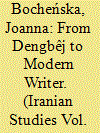

|
|
|
|
|
| Summary/Abstract |
Based on a textual analysis of the selected works of two writers from Turkey, Mehmed Uzun (1953–2007) and Mehmet Dicle (b.1977), as well as interviews with Kurdish writers and folklore collectors, this study focuses on the links between Kurdish folklore and modern Kurdish literature. Following Gregory Ashcroft's take on heritage, I argue that Kurdish writers’ approach to folkloric motives has evolved through the impact of growing literary experience, inspiration from world literature and deepening knowledge of the Kurdish oral tradition. What is more, Kurdish literature can be treated as an example of cultural and language revitalization, which – according to Justyna Olko – is based on acting in and through the heritage language. Following Doreen Massey's concept of a progressive sense of place, I identify Uzun and Dicle's strategy as linking the local to the universal, suggesting that Kurdish literature should be analyzed within the context of a political geography beyond nationalism.
|
|
|
|
|
|
|
|
|
|
|
|
|
|
|
|
| 4 |
ID:
186909
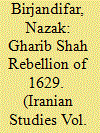

|
|
|
|
|
| Summary/Abstract |
The Gharib Shah Rebellion erupted in Gilan in 1629, shortly after the death of Shah ʿAbbas I and the ascension of Shah Safi I to the throne. A close engagement with Gilani chronicles reveals the uprising was motivated by anti-Safavid sentiment and a desire to restore autonomous rule in Gilan. The Gharib Shah Rebellion is best understood in the context of the series of post-conquest rebellions in Gilan, which had both political and economic motivations. It marked the final attempt to regain autonomy from the Safavids, nearly forty years after their conquest of the region. While messianism was not completely absent in Gilan in this period, it was not a factor in this rebellion and its role, in general, has been over-emphasized.
|
|
|
|
|
|
|
|
|
|
|
|
|
|
|
|
| 5 |
ID:
186905
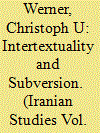

|
|
|
|
|
| Summary/Abstract |
This study proposes an innovative, triangular close reading of three Persian authors: Nezāmi, Golshiri, and Mandanipour. It argues that the two modern authors, Hushang Golshiri with his famous novella Shāh-e siyāhpushān, the “King of those clad in black,” and Shahriar Mandanipour in his Censoring an Iranian Love Story, are not only bound to each other in a close master-disciple relationship, but also consciously expound on the subversive potential of the twelfth-century poet Nezāmi. In the process, the divide between modern and classical narrative traditions in Persian literature is bound to disappear, allowing for novel interpretations and perspectives on Nezāmi and for his epics to be heard.
|
|
|
|
|
|
|
|
|
|
|
|
|
|
|
|
| 6 |
ID:
186910
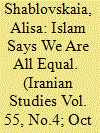

|
|
|
|
|
| Summary/Abstract |
The early 1920s witnessed an upsurge in Soviet interest in Islam on an international scale. This interest was to a large extent guided by Great Game logic, at a time when the idea of Islamic jihad against the British was extremely popular all over the Middle East. Contrary to the common assumption that the Marxist rationale of the Bolsheviks excluded any possibility of integrating religion into Soviet policy, the highest authorities in Moscow adopted a rather opportunistic position with regard to Islam both at home and abroad. Drawing mainly on Russian archival sources, this study questions the origins and nature of the Islamic turn in Soviet discourse, diplomacy, and propaganda in Iran. The article concludes that although the Soviet rapprochement with some members of the Iranian clergy and the integration of religious elements into communist propaganda were carried out for the sake of short-term geopolitical goals, these maneuvers were much conditioned by Soviet domestic policy and post–World War I regional interdependencies.
|
|
|
|
|
|
|
|
|
|
|
|
|
|
|
|
| 7 |
ID:
186913


|
|
|
|
|
| Summary/Abstract |
Mathematics is a particularly important challenge for embodied approaches to cognition, as it is probably the most abstract domain of human knowledge. Humans use metaphors in all aspects of life. This paper studies the effects of human body parts on numerals, numeral systems, and mensural and sortal classifiers. The evidence for this paper comes from the Tāti language group, an endangered Iranian language of the Indo-European language family. The Tāti data shows these languages make use of base-10, base-20, and base-50 numeral systems, some of which are among the most common and earliest counting systems worldwide, while the last is unique and peculiar to the area. Body parts may also play an important role in forming mensural and sortal classifiers, as is the case in the Tāti language group.
|
|
|
|
|
|
|
|
|
|
|
|
|
|
|
|
| 8 |
ID:
186908


|
|
|
|
|
| Summary/Abstract |
This paper investigates the activities of the KGB residency in Iran during the 1978–79 revolution and early years of the Islamic Republic. While some foreign experts were quick to point to the KGB as behind the revolution, it soon became clear that Soviet leadership and intelligence were no less surprised with the events than their counterparts in the West. However, this does not mean that Moscow did not see the revolution as an opportunity. The KGB served as one of the principal tools of Soviet attempts to influence the domestic situation in Iran and, although it achieved little in pursuing its goals, KGB activities in Iran reveal the extent to which binary Cold War thinking limited Soviet leadership in dealing with the challenge of the Iranian revolution.
|
|
|
|
|
|
|
|
|
|
|
|
|
|
|
|
| 9 |
ID:
186915
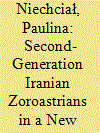

|
|
|
|
|
| Summary/Abstract |
The article contributes to filling the research gap concerning Iranian Zoroastrians in diaspora. Using a narrative approach, it explores how second-generation Zoroastrians raised in the United States learn and practice religion while facing the challenges of a pluralistic American society. The article includes a case study of two young Zoroastrian women interviewed in 2019, members of the Californian community. The contrastive cases shed light on the internal heterogeneity of Zoroastrianism, different ways the religion is perceived and experienced, and different ideas about future preservation of the ethno-religious heritage. The study contributes to an understanding of how Zoroastrianism evolves on a new continent and how it differs from what Zoroastrian immigrants brought from Iran.
|
|
|
|
|
|
|
|
|
|
|
|
|
|
|
|
| 10 |
ID:
186914
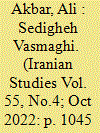

|
|
|
|
|
| Summary/Abstract |
This article explores the ideas of Iranian reformist scholar Sedigheh Vasmaghi and her contribution to religious reformist thought in Iran. As this article demonstrates, a significant aspect of Vasmaghi's work concerns how she understands the extent to which the legal aspects of the Qurʾān and the associated rulings found in fiqh literature are relevant to the conditions of the modern world. This article investigates Vasmaghi's ideas about the Qurʾān and her contextualist approach to interpretation, arguing that her views on Islam's socio-legal rulings are rooted in her approach to the Qurʾān. As the article will demonstrate, Vasmaghi's ideas add to the work of other prominent Iranian reformist scholars such as Abdolkarim Soroush, Muhammad Mujtahed Shabestari, Mohsen Kadivar and Hassan Yousefi Eshkevari, but her approach is also subject to criticism, in particular her manner of differentiating between the mutable and immutable aspects of religion.
|
|
|
|
|
|
|
|
|
|
|
|
|
|
|
|
| 11 |
ID:
186904
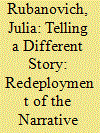

|
|
|
|
|
| Summary/Abstract |
This article explores the remaniement of three episodes current in the Perso-Arabic Alexander tradition—i.e., Eskandar's confrontation with the Indian king Fur; Eskandar's visit to Queen Qeydāfeh; and Eskandar's encounter with the Gymnosophists—in the anonymous Persian Eskandarnāmeh, a medieval epic narrative in prose (dāstān; ca. 12th–14th c.). Through extensive comparative evidence from other genres, primarily narrative poetry (Ferdowsi's Shāhnāmeh, Nezāmi's Sharafnāmeh and Eqbālnāmeh), mirabilia (ʿajāyeb), and exegetical works (qesas al-anbeyāʾ and tafsir), this study engages with how the modalities of the dāstān genre, with its strong leaning towards traditional oral storytelling, affect the narrative choices Eskandarnāmeh's author makes in treating these themes. In so doing, this article attempts to develop a more informed assessment of the strategies and devices which, activated both on the production and reception planes, generate competing interpretations of well-known plots recast in different narrative modes.
|
|
|
|
|
|
|
|
|
|
|
|
|
|
|
|
| 12 |
ID:
186906


|
|
|
|
|
| Summary/Abstract |
The Safīna-yi Sulaymānī (The Ship of Sulaymān), one of the foremost Persian travelogues from the Safavid period, includes a geographic description of East and Southeast Asia centered on the Indian Ocean. While the Safīna is well-known to scholars, secondary literature on this part of the book is scant and often characterizes it as incoherent and devoid of value. This paper challenges this interpretation through providing a new reading of this text. By casting it in a comparative framework with earlier books of wonders, this paper argues that the geographic section of the Safīna articulates an original view of the Indian Ocean resulting from the encounter between the traveler's observations and experiences and the Islamic tradition of wonders, the ʿajāʾib. As such, it encapsulates one of the central intellectual developments in early modern knowledge production, i.e., the tension between independent inquiry (taḥqīq) and imitation of earlier authorities (taqlīd).
|
|
|
|
|
|
|
|
|
|
|
|
|
|
|
|
|
|
|
|
|